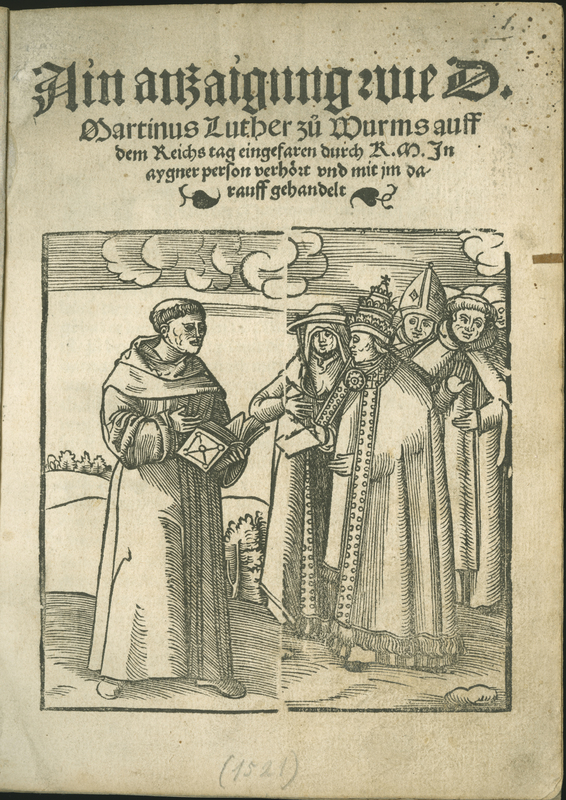Search
-
 Still image
Still imageThree Weddings
A woodcut depicting the wedding ceremonies of three clergy members with musicians (top) playing accompaniment. -
 Still image
Still imageMartin Luther
A woodcut portrait of Martin Luther dressed in the traditional garb of an Augustinian monk and holding a book, likely a Bible, and flanked by two decorated pillars. Appears to be done after the woodcut portrait by Hans Baldung. -
 Still image
Still imageHistoriated title page of Luther's Iudicium de votis
Cranach, Lucas, 1472-1553A woodcut border on the title page of Luther's Iudicium de votis printed in 1521. The border is done as a single woodcut depicting a monk (left), a nun (right), a Green Man of pagan and Christian lore (bottom), and a bowl of fruit (top). The intermediate spaces are filled with floral and plant decorative motifs. -
 Still image
Still imageMartin Luther and the Holy Spirit
Baldung, Hans, -1545A woodcut portrait of Martin Luther dressed in the traditional garb of an Augustinian monk and holding a book, likely a Bible, with a dove above him, representing the Holy Spirit. -
 Still image
Still imageHistoriated title page of Karlstadt's treatise on canonical books
A woodcut border on the title page of Karlstadt's treatise on which books should be considered canonical alongside the Bible. The border is made up of four separate woodcuts, all with unique floral designs. -
 Still image
Still imageHieronymus Emser's Coat of Arms
A woodcut depicting Hieronymus Emser's coat of arms which features a shield emblazoned with a goat's head and a helmet crowned with a goat's head. A label to the side of the crest reads "ARMA HIERONYMI EMSER". -
 Still image
Still imageLuther in debate with Cathoic clergy
A woodcut depicting Martin Luther, in the garb of an Augustinian monk, debating a gathering of Catholic clergy members, including the Pope, a cardinal, a bishop, and a monk. This woodcut appears on the title page of a popular anonymous account of Luther's debate before the Diet of Worms in 1521. -
 Still image
Still imageMartin Luther as an Augustinian Monk
A woodcut depicting Martin Luther in the garb of an Augustinian Monk. Below Luther is a traditional Luther rose. Surrounding the portrait is an inscription, mirrored as the image was printed in reverse, reading "DOCTOR MARTINUS LUTTER AUGUSTINER: WITTENB:". This is purported to be the earliest depiction of Luther. -
 Still image
Still imagePrinter's Device of Johann Schott
A woodcut of Johann Schott's printer's device, depicting a pair of dogs fighting, each biting the other's back and the initials "RSM". -
 Still image
Still imageMartin Luther
Baldung, Hans, -1545A woodcut portrait of Martin Luther dressed in the traditional garb of an Augustinian monk and holding a book, likely a Bible. This woodcut appears on the title page of Luther's work De captivitate Babylonica ecclesiae praeludium. -
 Still image
Still imagePrinter's Device of Johann Schott
A woodcut of Johann Schott's printer's device, depicting a pair of dogs fighting, each biting the other's back and the initials "RSM". This version includes additional rubrication to highlight the points where each dog is biting. -
 Still image
Still imageMartin Luther
Baldung, Hans, -1545A woodcut portrait of Martin Luther dressed in the traditional garb of an Augustinian monk and holding a book, likely a Bible. This woodcut appears on the title page of the German translation of Luther's work De captivitate Babylonica ecclesiae praeludium. -
 Still image
Still imageThe Ninth and Tenth Commandments
A pair of woodcuts depicting a man kneeling beside a woman (left) and a two men in a building while a third sits at a table possibly counting money or grain (right), representing the Ninth and Tenth Commandments (in the Lutheran tradition), "Thou shalt not covet thy neighbor's wife, or his slaves, or his animals, or anything of thy neighbor." -
 Still image
Still imageThe Eighth Commandment
A woodcut depicting a trial with a judge, a woman kneeling (the accused), and a man delivering a (presumably false) witness statement, representing a violation of the Eighth Commandment (in the Lutheran tradition), "Thou shalt not bear false witness against thy neighbor." -
 Still image
Still imageThe Seventh Commandment
A woodcut depicting a man stealing from another's purse as the victim carries on a conversation, representing a violation of the Seventh Commandment (in the Lutheran tradition), "Thou shalt not steal." -
 Still image
Still imageThe Sixth Commandment
A woodcut depicting a man and woman in bed together, thereby representing a violation of the Sixth Commandment (in the Lutheran tradition), "Thou shalt not commit adultry." -
 Still image
Still imageThe Fifth Commandment
A woodcut depicting a man murdering two individuals with an axe, thereby representing a violation of the Fifth Commandment (in the Lutheran tradition), "Thou shalt not murder." -
 Still image
Still imageThe Fourth Commandment
A woodcut depicting a son and daughter washing the feet of their mother and father respectively, thereby representing the Fourth Commandment (in the Lutheran tradition), "Honor thy father and thy mother." -
 Still image
Still imageThe Third Commandment
A woodcut depicting a congregation gathered around a crucified Christ to hear the preaching of the Christian faith, thereby representing the Third Commandment (in the Lutheran tradition), "Remember the sabbath day, to keep it holy." -
 Still image
Still imageThe Crucifixion of Christ
A woodcut depicting two men gambling in the foreground as Christ is crucified and stabbed in the background. -
 Still image
Still imageThe First Commandment
A woodcut depicting a violation of and proper following of the First Commandment (in the Lutheran tradition), "Thou shalt have no other god before me." On the right, a group of worshipers gather around the crucified Christ thereby following the First Commandment. In contrast, on the left, a group worships an "idol" in the form of a horned figure on a pedestal.